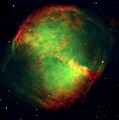File:M27 - Dumbbell Nebula.jpg

本预览的尺寸:600 × 599像素。 其他分辨率:240 × 240像素 | 480 × 480像素 | 769 × 768像素 | 1,025 × 1,024像素 | 2,044 × 2,042像素。
原始文件 (2,044 × 2,042像素,文件大小:1.74 MB,MIME类型:image/jpeg)
文件历史
点击某个日期/时间查看对应时刻的文件。
| 日期/时间 | 缩略图 | 大小 | 用户 | 备注 | |
|---|---|---|---|---|---|
| 当前 | 2022年8月25日 (四) 18:14 |  | 2,044 × 2,042(1.74 MB) | Fabian RRRR | from the actual source |
| 2010年3月2日 (二) 08:34 |  | 4,961 × 5,004(3.04 MB) | Tryphon | Higher resolution, from http://www.eso.org/public/archives/images/large/eso9846a.jpg. | |
| 2008年9月18日 (四) 09:02 |  | 3,966 × 4,000(849 KB) | Lars Lindberg Christensen | {{Information |Description={{en|1=The Dumbbell Nebula - also known as Messier 27 or NGC 6853 - is a typical planetary nebula and is located in the constellation Vulpecula (The Fox). The distance is rather uncertain, but is believed to be around 1200 light |
文件用途
全域文件用途
以下其他wiki使用此文件:
- af.wikipedia.org上的用途
- ar.wikipedia.org上的用途
- arz.wikipedia.org上的用途
- ast.wikipedia.org上的用途
- az.wikipedia.org上的用途
- bs.wikipedia.org上的用途
- ca.wikipedia.org上的用途
- ckb.wikipedia.org上的用途
- cs.wikipedia.org上的用途
- de.wikipedia.org上的用途
- el.wikipedia.org上的用途
- en.wikipedia.org上的用途
- en.wikibooks.org上的用途
- es.wikipedia.org上的用途
- et.wikipedia.org上的用途
- eu.wikipedia.org上的用途
- fi.wikipedia.org上的用途
- fr.wikipedia.org上的用途
- fr.wikibooks.org上的用途
- he.wikipedia.org上的用途
- hu.wikipedia.org上的用途
- id.wikipedia.org上的用途
- it.wikipedia.org上的用途
查看本文件的更多全域用途。

